Guitar Parts: a Guide for Acoustic & Electric Guitars
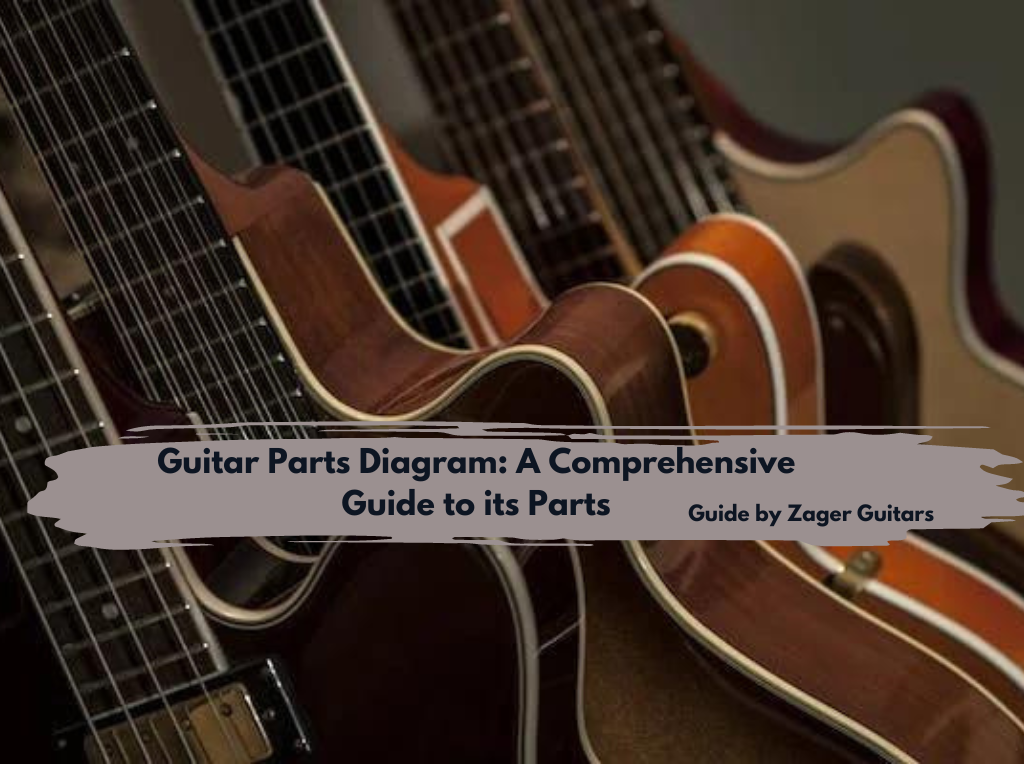
Picture this: a masterful symphony of craftsmanship, where over 20 distinct parts come together in perfect harmony to create the iconic instrument we call the guitar. From the beautiful tonewoods to the resolute headstock, each component plays a vital role in producing the captivating melodies that stir our souls.
Join us on an exhilarating journey as we unravel the secrets of the guitar’s anatomy, leaving no fret unturned. Brace yourself for an exploration filled with intrigue and awe as we dive deep into the intricacies of electric guitar parts: the machine/tuning nuts, the whimsical string trees, and the mighty truss rod.
But that’s just the beginning! We’ll venture further into uncharted territory, uncovering the mysteries of the volutes, the nut, and the neck, where the magic truly takes shape. Prepare to be mesmerized by the fretboard’s graceful curves and the ethereal vibrations of the strings that dance beneath your fingertips.
Hold on tight as we navigate the fascinating realm of the guitar’s functionality. We’ll unravel the enigma behind the action, the neck joint and heel secrets, and the transformative powers of the body. Delve into the world of pickup & sound hole wizardry and explore the electrifying controls that allow you to shape your sonic destiny.
But wait, there’s more! Brace yourself for the riveting tales of the bridge pickup, the tailpiece, and the delicate dance of intonation. Discover the unsung hero, the end pin, and the jack socket that serves as gateways to sonic exploration and connectivity.
Are you ready for this thrilling expedition through the guitar’s inner sanctum? Join us as we uncover the wonders within these 20+ mesmerizing components. From the raw power of tonewoods to the intricate craftsmanship of every last detail, prepare to witness the guitar’s mesmerizing symphony of creation come alive before your very eyes. Let the journey begin!
Guitar Parts
- Headstock
- Neck
- Body
- Bridge
- Picks
- Tuners
- String Tree
- Truss Rod Cover
- Fretboard
- Truss Rod
- Inlays
- Saddle
Acoustic and Electric Guitars
In a world where music reigns supreme, a legendary battle unfolds, pitting two guitar giants against each other: acoustic guitars versus electric guitars. Brace yourself for an epic showdown as we dive deep into the distinctive trinities that define these sonic powerhouses. So folks, prepare for a thrilling journey through musical history, innovation, and boundless artistic expression.
In one corner is the acoustic guitar, a time-honored symbol of soulful melodies and intimate gatherings around a campfire. Its trinity of greatness starts with the mesmerizing acoustic headstock, evoking visions of bygone eras and heartfelt serenades beneath a starlit sky. mg

The neck truly steals the show, beckoning players with its wide fretboard, inviting fingers to traverse its expanse and weave intricate tapestries of melody.
Then there’s the body, a magnificent work of art meticulously crafted to resonate and amplify the raw power of acoustic sound. From delicate fingerpicking to resounding strums, the acoustic guitar’s trinity envelops listeners in a warm embrace, evoking emotions that transcend time.
On the opposite side of the ring, we have the electric guitar, a symbol of untamed creativity and rock ‘n’ roll rebellion. Its electrifying trinity sets the stage for the sonic revolution. Behold the first electric guitar bridge headstock, a futuristic marvel housing a collection of tuning keys ready to unlock a world of tonal wizardry. mg

The neck ignites the imagination with its sleek profile and lightning-fast fretboard, empowering players to unleash lightning-quick riffs and mind-bending solos.
Enter the body, often solid and elegant, a catalyst for sonic exploration and experimentation. From scorching guitar solos to earth-shaking power chords, the electric guitar’s trinity electrifies the air with its versatility and endless tonal possibilities. Get ready to witness the birth of Sonic Legends!
As these two guitar titans collide, their trinities reveal a stark contrast in sonic character. The acoustic guitar, rooted in tradition, captivates with its organic resonance, inviting listeners into a world of heartfelt emotion. Meanwhile, the electric guitar is a catalyst for sonic innovation, and unleashes a whirlwind of amplified energy, pushing boundaries and redefining what’s possible in music.

Acoustic Guitar
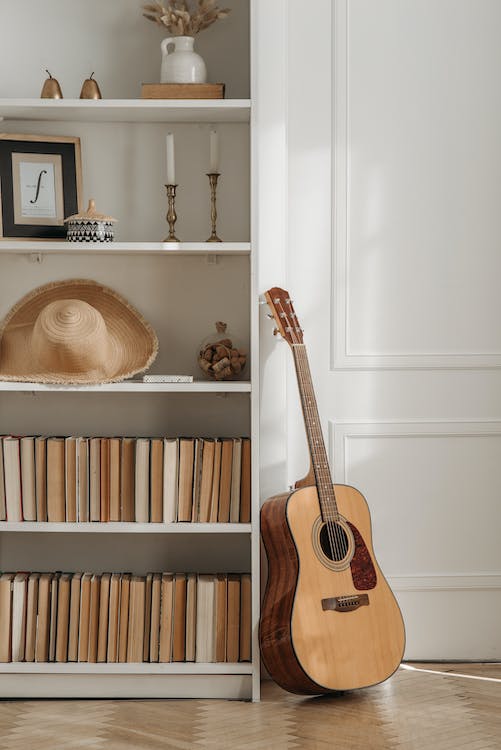
Unlike its electric counterpart, the acoustic body is an actual work of art, meticulously crafted from a symphony of components. It’s a harmonious dance of precision and creativity, where the top, sides, and back are skillfully assembled with the help of specialized jigs and adhesive. Each piece finds its place, combining to form a resonant chamber that holds the secrets of sonic enchantment.
But what lies beneath the surface is where the true magic happens. Enter the world of bracing – a secret weapon in the acoustic body’s arsenal. Like an invisible backbone, bracing provides strength and stability, allowing the body to withstand the mighty tension of the strings. It’s a delicate balance, carefully crafted to enable the body to resonate freely, producing the deep bass and powerful volume that captivates our souls.
Now, let’s turn our attention to the heart of this sonic marvel – the sound hole. Positioned at the center of the acoustic guitar bridge body, it’s a portal to another realm, a gateway to musical wonder. When the strings are strummed, plucked, or caressed, the vibrations course through the body, escaping through the sound hole with resounding clarity and beauty.
It’s a magical moment when the acoustic body comes alive, filling the air with its soul-stirring melody.mg
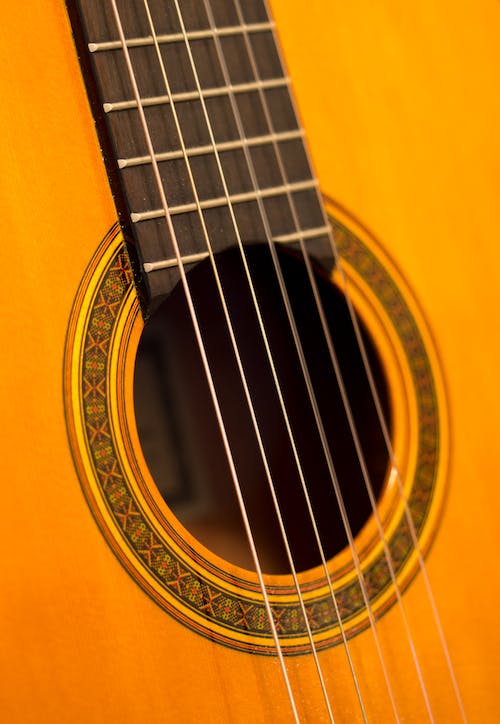
But the wonders don’t end there. In the realm of acoustic guitars, diversity reigns supreme. While the classic round sound hole is a timeless favorite, the world of acoustic bodies boasts a breathtaking array of shapes and configurations.
Oval holes, multiple sound holes scattered across the body – the possibilities are as endless as the artist’s imagination. Each design choice adds a unique touch, influencing the aesthetics and sound delivery, ensuring a genuinely individualistic musical experience.mg

Allow yourself to be captivated by the artistry, precision, and limitless potential that resides within. Let the strings resonate, let the sound hole sing, and immerse yourself in the symphony of the acoustic body. It’s a journey that will ignite your passion for music and reveal the true power of this great instrument.
Get ready to be swept away by the irresistible allure of the acoustic body’s harmonious symphony!
Electric Guitar
Imagine yourself on a stage surrounded by roaring fans, eagerly waiting for the first notes to fill the air. As you grip your electric guitar, ready to unleash your sonic magic, you might wonder: Does the body of this instrument truly make a difference? Is it just a hollow shell, or does it play a vital role in shaping the volume and tone knob, that will captivate your audience? mg
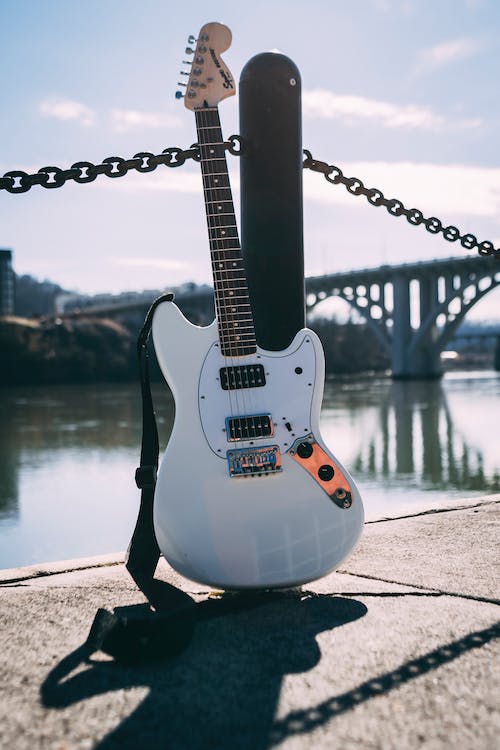
At first glance, it may seem like the electric guitar body is simply a vessel to hold the pickups and other components. After all, it doesn’t project sound like an acoustic guitar or a hollow-body instrument. Some skeptics may even claim that the body does not affect the electric guitar’s tone. But let me assure you, my friend, that couldn’t be further from the truth!
Every electric guitar body is a unique creation, crafted from carefully selected tonewoods that possess their sonic character. When you strike those strings with precision and passion, the vibrations are unleashed, traveling through the bridge and into the body. And here’s where the magic happens.mg
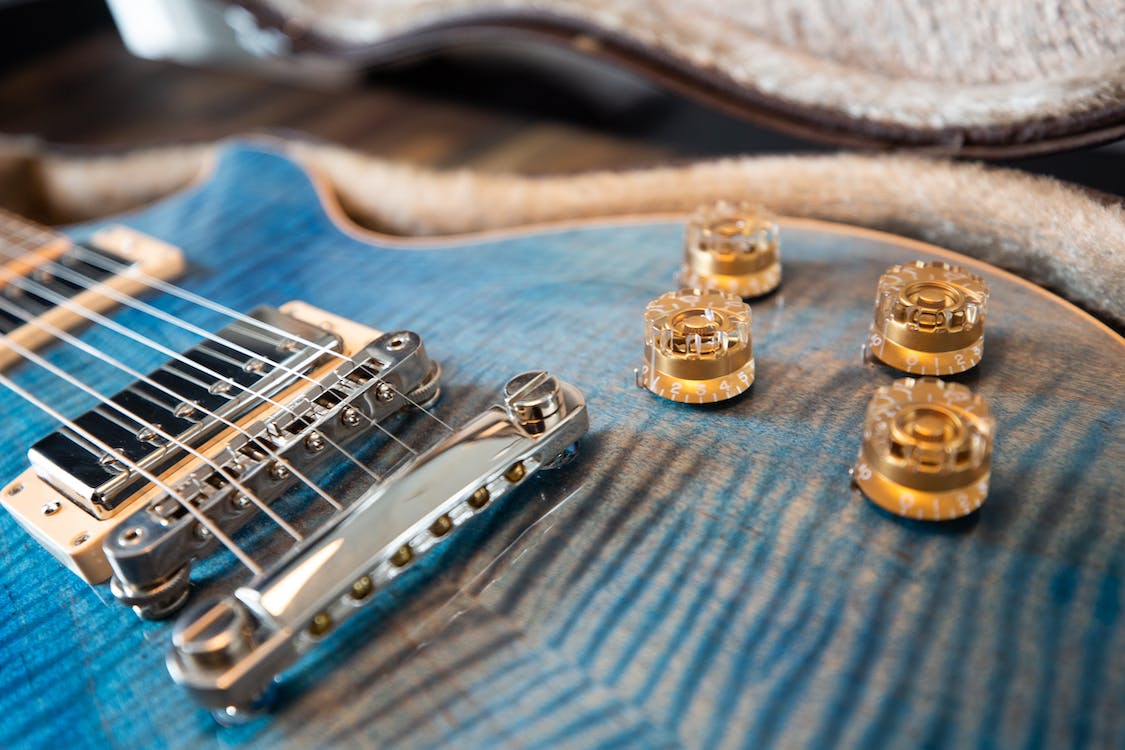
Like a conductor shaping an orchestra, the electric guitar body interacts with those vibrating strings, adding its signature touch to the sonic symphony. Different tonewoods vibrate distinctively, influencing how sound waves travel within the instrument.
Picture a world where the body is made of mahogany. As the strings vibrate, this warm-toned wood dances harmoniously with the musical vibrations, infusing your sound with a luscious richness. It’s like a warm embrace that envelops your audience, drawing them deeper into the sonic tapestry you’re weaving.mg
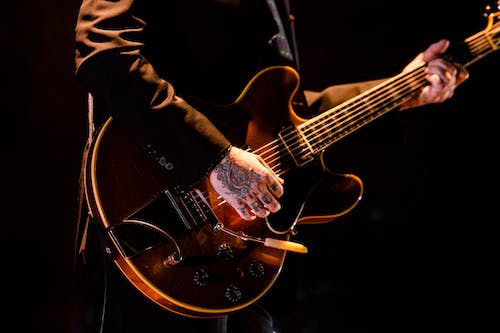
Now, let’s shift gears to a different tonewood, like ash. Its bright and articulate nature adds sparkling clarity to your playing. The notes spring to life, shining through the mix with a vibrant energy that cuts through the air like a lightning bolt.
But the tonewoods are just the beginning of the story. The body’s density, weight, and grain structure also play. These factors affect how the body resonates, how the vibrations sustain, and how the instrument responds to different frequencies.mg

Think of your electric guitar body as a partner in crime, working in harmony with your pickups—the real workhorses of your sound. While the pickups do the heavy lifting of capturing the strings’ vibrations and transforming them into an electrical signal, the body molds that signal into something special. It’s a collaboration between technology and nature, where the sum is more significant than its parts.
So, my fellow guitarist, feel the electric guitar body vibrate beneath your fingertips the next time you strum those strings. Embrace the symbiotic relationship between the tonewoods, the pickups, and your playing style. Let the body’s unique qualities shape your tone, and watch your music take on a new dimension.
Remember, the electric guitar body may not project sound like an acoustic guitar, but its influence on your tone is natural. It’s a secret weapon, a partner in crime, and an unsung hero in the rock ‘n’ roll world.
Parts of a Guitar
Now, let’s explore the various parts of a guitar, beginning with the headstock and gradually making our way down.
Headstock
At the very top of the guitar, we find the headstock, also known as the head. This section is where you’ll encounter the tuning pegs or machine heads, which are used to adjust the tension of the guitar strings. By turning these pegs, you can raise or lower the pitch of each line, enabling you to achieve the desired tuning for your instrument. The headstock is a functional component and often showcases the guitar’s brand logo or design, adding a touch of visual flair.
Neck
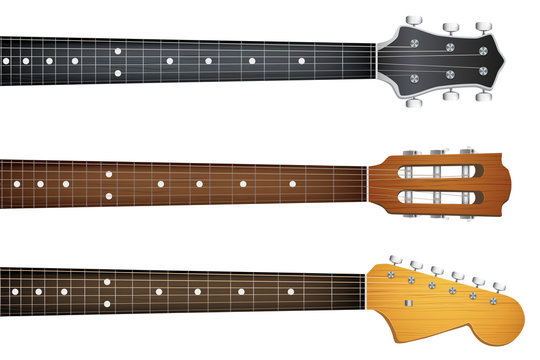
Let’s move on to the neck. The neck extends from the headstock and provides a platform for frets, strings, and your fingers. Typically made of wood, the channel narrows near the headstock and gradually widens as it approaches the body. It may feature a fretboard, a flat or slightly curved surface often made of wood (such as rosewood or maple) that houses the metal frets.
The neck plays a crucial role in determining the feel and playability of the guitar, influencing factors like string action (the height of the strings above the fretboard) and neck shape, which can vary from thin and fast to thick and chunky.
Body
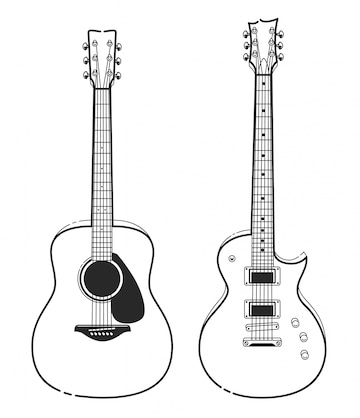
Moving down, we encounter the body of the guitar. In the case of an electric guitar, the body is typically a solid piece of wood. This is where the magic happens! The body holds the pickups, bridge, controls, and other hardware. It also acts as a resonating chamber, contributing to the guitar’s overall tone and sustain.
Different tonewoods, such as mahogany, ash, or alder, can influence the instrument’s sound characteristics. The body’s shape and contours also play a role in ergonomics and comfort, allowing the guitar to sit comfortably against your body while you play.
Bridge
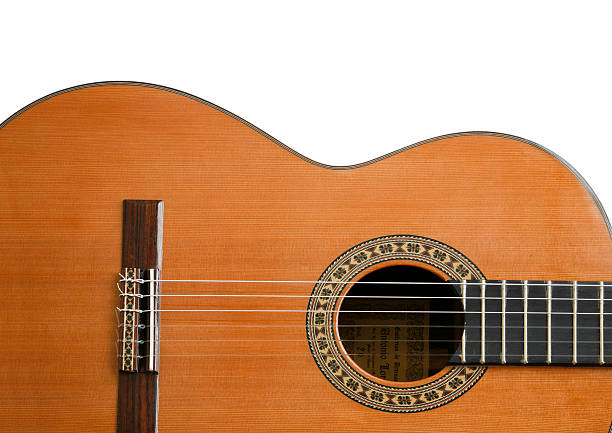
Next up is the bridge. The bridge is a crucial component that anchors the strings to the body. It can come in various forms, such as a fixed bridge or a tremolo bridge (a whammy bar or vibrato system).
It The bridge helps transmit the string vibrations to the body, allowing them to resonate and contribute to the overall sound. BridgeIt also enables you to adjust the string height (action) and intonation, ensuring accurate pitch across the fretboard.
Picks
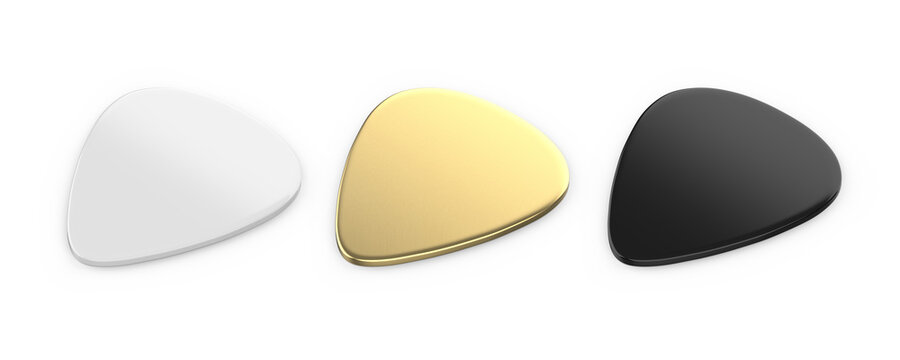
These are the heart and soul of an electric guitar’s sound. Pickups are essentially magnets with wire coils wound around them. They capture the vibrations of the strings and convert them into electrical signals. These signals are then sent through cables to an amplifier or audio interface, where they are further shaped and amplified.
Electric guitars often feature multiple pickups, such as single coils or humbuckers, which offer different tonal characteristics. You can use switches and knobs on the guitar’s body to select other pickups or adjust volume and tone settings.
Tuners
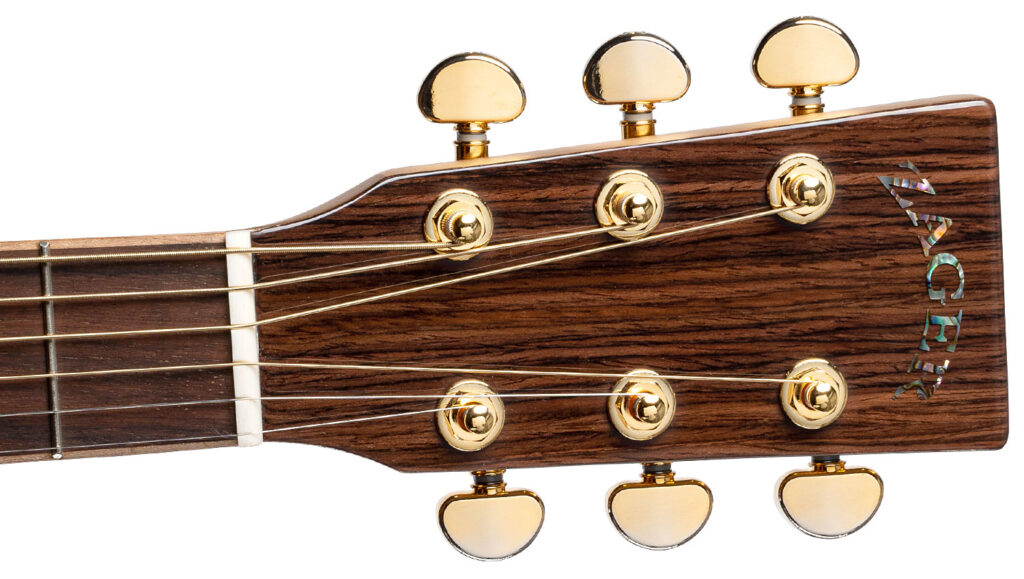
Except for some headless guitars and electric guitars, the tuners are typically located on the headstock of an electric guitar. The tuners consist of several parts, including tuning pegs, tuning posts, and more. However, when referring to the entire unit, it is commonly referred to as a tuner.
On a standard 6-string guitar, you will find six tuners. The most common tuner layouts are either six-in-line, where all six tuners are aligned in a straight line, or 3+3, where three are on one side of the headstock and the other three are on the opposite. In the diagram provided, the Fender Stratocaster headstock on the left demonstrates a six-in-line layout, while the Gibson Les Paul on the right showcases a 3+3 configuration.
The tuning pegs, also known as tuning buttons, are the parts of the tuners that you turn to tighten or loosen the guitar strings. The tuning post is the section where you thread and wind the strings. While a tuner has additional components, understanding the tuning pegs and tuning posts is typically sufficient.
So, whether you’re adjusting the tension to achieve the perfect pitch or experimenting with different tunings, the tuners on the headstock are the trusty companions that allow you to fine-tune your guitar strings and embark on your musical journey.
String Tree

cc: Wikipedia
Certain electric guitars, like the Fender Stratocaster on the left in the previous diagram, often feature a string tree on the headstock. The purpose of the string tree is to provide additional pressure, ensuring that the strings remain securely seated within the nut.
The string tree consists of arms or bars under which the guitar strings are threaded. By applying slight downward pressure to steel strings, the string tree helps maintain proper string tension and prevents them from slipping or moving out of position. This is particularly important for strings that are thinner and more prone to falling, such as the higher-pitched strings.
Beyond its functional role, the string tree can subtly impact the guitar’s sustain. When a string is played open (without fretting), the string tree sustains the note, allowing it to ring out longer. This can add richness and depth to open chords and notes, enhancing the overall sound and resonance of the instrument.
So, while often overlooked, the humble string tree plays a valuable role in maintaining proper string position and providing that extra touch of sustain, ensuring your electric guitar performs at its best.
Truss Rod Cover
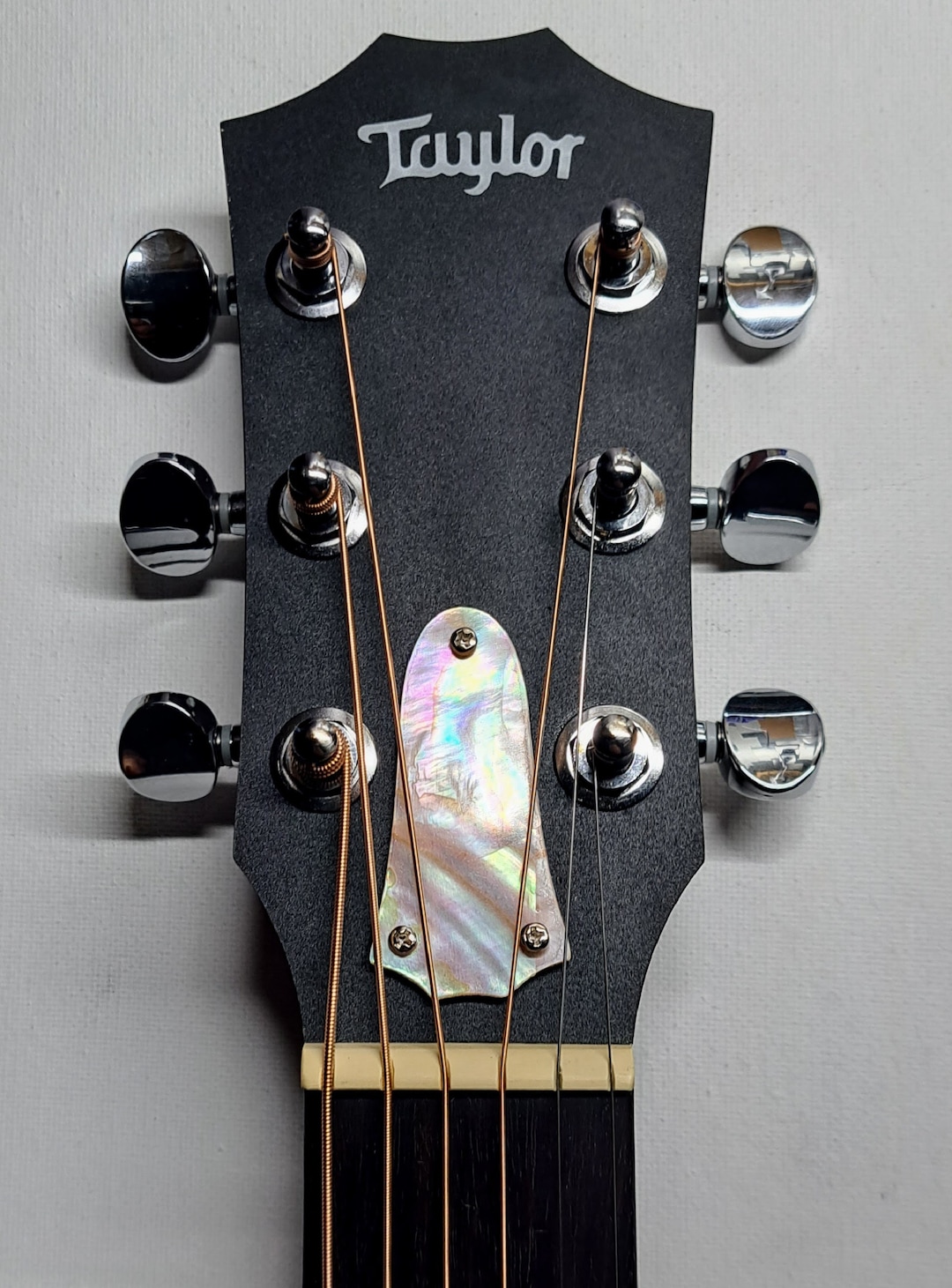
cc: Etsy
In certain headstocks, you may observe a small plastic cover positioned above the nut and beneath the guitar strings. This cover serves a purely aesthetic purpose and is intended to conceal the truss rod adjustment cavity.
The truss rod is a metal rod that runs inside the neck of the guitar and is used to counteract the tension exerted by the strings. Adjusting the truss rod can fine-tune the neck’s curvature and ensure optimal playability and string action. The access point for adjusting the truss rod is typically located either under the plastic cover on the headstock or at the opposite end of the fretboard, where it connects to the bridge and pins the guitar’s body.
However, on certain guitars, such as the Fender Stratocaster mentioned earlier, the access hole for the truss rod adjustment is left exposed or located elsewhere on solid body of the instrument. In these cases, no plastic cover hides the access point.
Whether the truss rod adjustment cavity is covered by a plastic section or left exposed, its purpose remains the same: to provide access for adjusting the truss rod and ensuring the guitar’s neck maintains proper alignment and playability.
Fretboard

The fretboard called the fingerboard, is a thin wooden slab affixed to the top of the guitar neck. It is made from various types of wood, contributing to tonal characteristics and influencing the tactile experience of playing the instrument.
Maple, rosewood, and Ebony are the most commonly used fretboard woods. Each wood type imparts unique qualities, affecting the fingerboard’s sound and feel. For instance, maple fretboards are known for their bright and snappy tones, while rosewood offers a warm and rich sound. On the other hand, Ebony is often prized for its smoothness and sleek aesthetic.
When examining a fretboard closely, you’ll notice that it is not entirely flat but has a slight curvature. This curvature is known as the fretboard radius. The fretboard’s radius can vary; a larger radius means a more level playing surface.
Different radius options, such as 7.25″, 9.5″, or even flat “compound” radii, offer distinct playing experiences and can impact how the strings feel under your fingers. The choice of fretboard radius is often a matter of personal preference and can influence the ease of string bending, chord voicings, and overall comfort while playing.
Therefore, the fretboard is responsible for providing a platform for fret placement and contributes to the guitar’s tone, playability, and overall character. It’s a crucial element influencing the feel and sounds you’ll experience while exploring the instrument.
Truss Rod
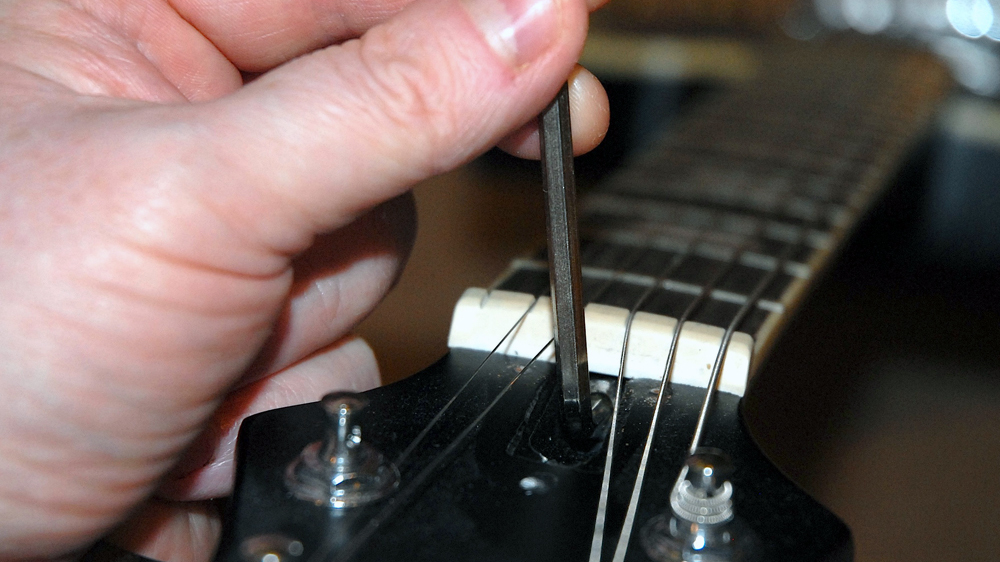
cc: Guitar World
The truss rod of a guitar is a metal bar that is adjustable and positioned within the neck, just below the fretboard. Its primary purpose is to enable the adjustment of the neck’s relief or curvature and provide stability against the tension exerted by the strings.
The truss rod plays a vital role in preventing excessive bowing or warping of the neck caused by string tension. Without the truss rod, the channel could bend to the degree that hampers playability, making it difficult to produce clear notes. Adjusting the truss rod, the neck’s curvature can be modified, allowing optimal playability and performance.
The access point for adjusting the truss rod is typically located under a truss rod cover on the headstock or at the junction of the neck and body. This access point allows guitar technicians or players to modify the truss rod precisely to maintain the desired neck relief.
P Periodic adjustments to the truss rod may be necessary, particularly when taking your guitar to a professional for a setup. A setup involves various adjustments and optimizations to ensure the guitar is in optimal playing condition. The truss rod may be adjusted to fine-tune the neck relief as part of this process.
In summary, the truss rod is a crucial component of a guitar’s neck, providing the means to adjust and stabilize the curvature against the string tension. The guitar can maintain good playability by carefully adjusting the truss rod and ensuring a comfortable and enjoyable playing experience.
Inlays
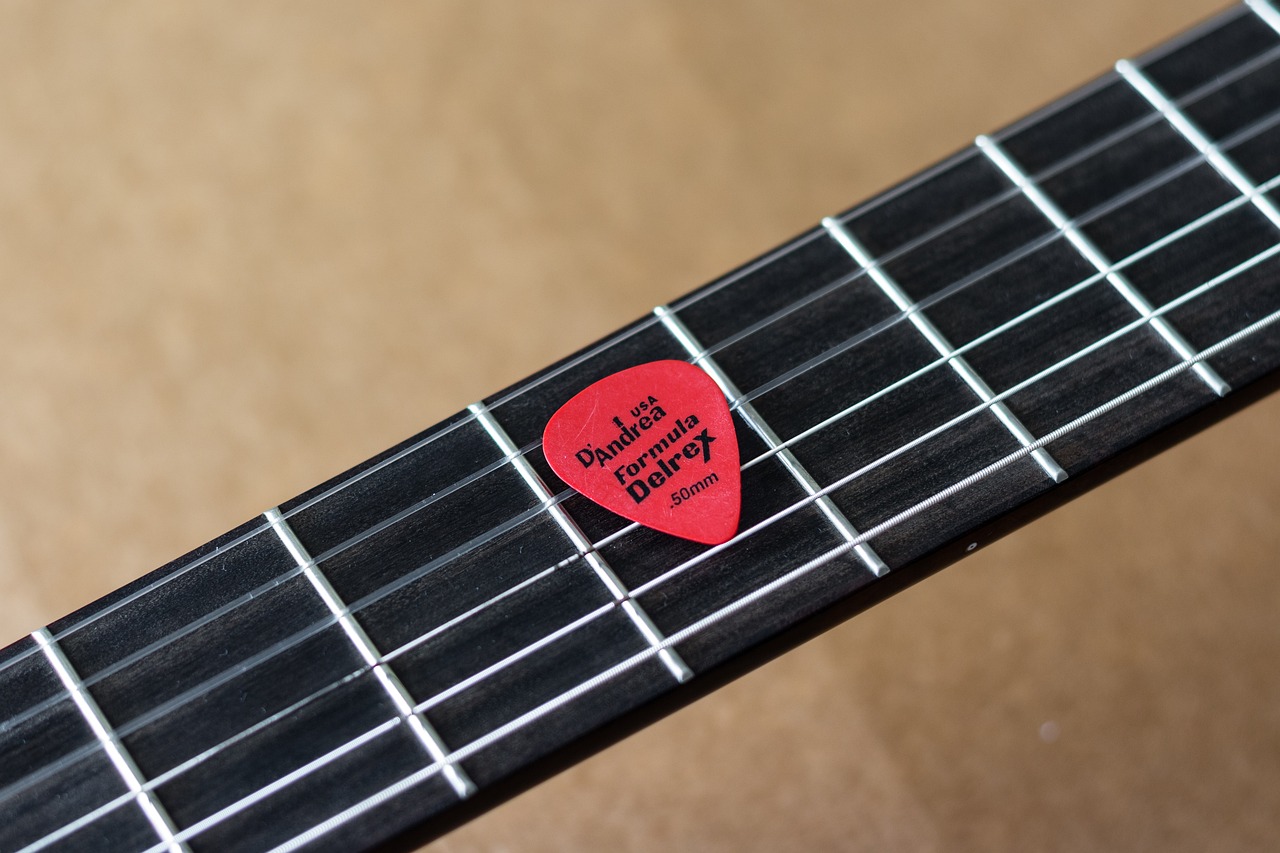
Running along the length of the fretboard, you’ll notice a series of markings that indicate the fret numbers. These markings, known as fret markers or position markers, can be dots, blocks, or more intricate designs.
Typically, fret markers are positioned at specific frets such as 3, 5, 7, 9, 12, 15, 17, 19, 21, and 24. Frets 12 and 24, in particular, often feature distinct inlay designs to indicate the octave positions. For example, they may have two dots instead of 1.
In addition to the markers on the fretboard, you will often find position markers on the side of the fretboard. These side markers serve as visual references while playing and are usually small dots.
Various materials are used to create these inlays. Standard options include plastic, abalone, mother of pearl, paua, and different types of wood. A modern choice that has gained popularity is Luminlay, a unique glow-in-the-dark material that proves particularly useful on dimly lit stages.
These fret markers and position markers provide a visual guide for players to navigate the fretboard and contribute to the instrument’s overall aesthetic appeal. They can vary in design and material, allowing for personalization and adding a touch of individuality to the guitar.
Overall, the fret markers and position markers on the fretboard and side of the neck are important visual indicators of the fret positions. They come in various materials and designs, combining functional and decorative elements to enhance your playing experience and add style to your instrument.
Saddle
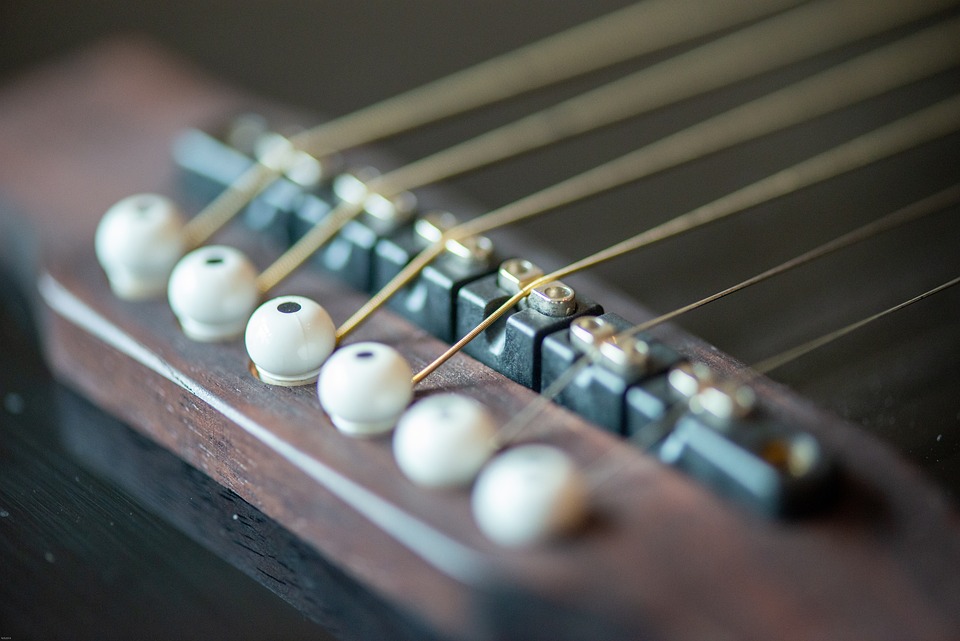
In the case of an acoustic guitar, the saddle is a slender piece of plastic or bone slotted into the bridge. Its primary function is to maintain the strings’ proper height and transmit vibrations from the lines to other parts of the guitar’s body through the acoustic bridge. The saddle also plays a role in the intonation of the guitar.
On the other hand, electric guitars typically feature individual saddles for each string, as seen on guitars like the Stratocaster mentioned earlier. However, some electric guitars, like the Fender Telecaster, may have a 3-saddle assembly.
The saddles on an electric guitar are usually equipped with adjustments to raise or lower the string height, commonly called “action.” Additionally, these saddles incorporate screws that allow for fine-tuning the string length, affecting the instrument’s intonation.
In the case of an acoustic guitar, adjusting the intonation can be more challenging. However, it is possible to change the string height by adding plastic shims beneath the saddle or modifying the harness by carefully removing the material.
Whether it’s an acoustic or electric guitar, the saddle is essential in maintaining proper string height, facilitating the transfer of vibrations, and contributing to the instrument’s overall playability and tonal characteristics. Understanding the saddle and its adjustment options is valuable for achieving optimal performance and intonation on both guitars.
So folks, with that we come to an end with our journey. Hopefully, you learned something fun today and can’t wait to get a guitar for your own self.
Frequently Asked Questions
The main parts of a guitar include the headstock, neck, body, bridge, strings, and various hardware components such as tuning pegs, pickups (for electric guitars), and the nut.
The headstock houses the tuning pegs, which are used to adjust the tension of the strings, thus tuning the guitar to the desired pitches.
The bridge on an acoustic guitar holds the strings in place and transfers the vibrations from the strings to the guitar’s body, contributing to the instrument’s sound projection and resonance.

